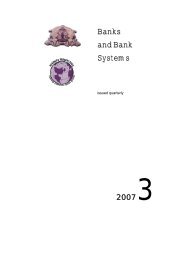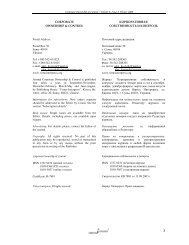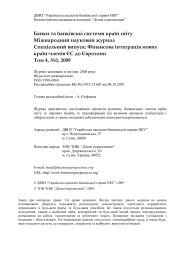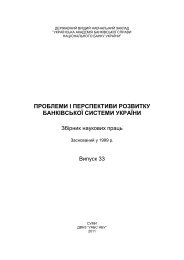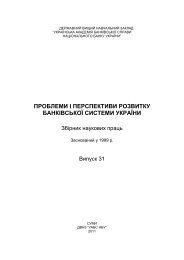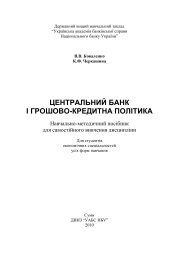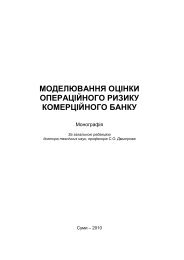BASEL II: PROBLEMS AND USAGE
BASEL II: PROBLEMS AND USAGE
BASEL II: PROBLEMS AND USAGE
You also want an ePaper? Increase the reach of your titles
YUMPU automatically turns print PDFs into web optimized ePapers that Google loves.
Small and medium-sized universal banks prefer to use the less sophisticated<br />
Standard Approach.<br />
Hence, despite the fact that Quantitative Impact Studies (QIS), which<br />
were conducted to assess the impact of Basel <strong>II</strong> on the banks’ capital requirements,<br />
revealed that the use of the advanced methods would be especially<br />
beneficial for small and medium-sized banks, 25 these banks prefer to<br />
use the Standard Approach. It is worth mentioning that there is a possibility<br />
of partial use of the IRBA, according to which the banks can implement the<br />
rating systems on a step-by-step basis within a period of five years. Actually,<br />
the average implementation period in case of the partial use constitutes<br />
three years.<br />
Although the number of rating systems submitted for approval ranges<br />
from one to 50, the most common methods are expert systems, simulation<br />
models, and credit scoring systems. 26 The latter use quantitative and qualitative<br />
data in order to assign a score to a borrower, which reflects his creditworthiness.<br />
The most popular statistical tools employed are discriminate<br />
analysis and probability models. 27 Scoring systems are primarily used in<br />
retail business and for small and medium-sized enterprises. Expert systems<br />
are applied to evaluate the credit risk of large corporate borrowers. Finally,<br />
simulation methods are employed for specialized lending and project finance.<br />
In practice, a mixture of all three methods is also used. 28<br />
5.2. Model Validation Techniques<br />
Whichever of the aforementioned internal ratings-based methods is<br />
applied to model the credit risk, it has to be of high quality to ensure the<br />
correct reflection of the bank’s credit risk exposure. Various validation<br />
techniques were developed to evaluate the quality of internal rating models.<br />
Basel <strong>II</strong> devotes special attention to the validation issue; banks applying for<br />
IRBA implementation have to convince the supervisor in the appropriateness<br />
of their models. One way of validating the rating model is to measure<br />
its discriminative power, i.e. the ability to distinguish between defaulters<br />
and non-defaulters. The most popular validation techniques include the<br />
Cumulative Accuracy Profile (CAP) and the Receiver Operating Characteristic<br />
(ROC). 29<br />
25 See Deutsche Bundesbank (2006).<br />
26 See Deutsche Bundesbank (2009).<br />
27 These models include the linear probability model, the logit model, and the probit<br />
model.<br />
28 See Deutsche Bundesbank (2009).<br />
29 This subsection is based on Beinert/Reichling/Vogt (2007).<br />
30



